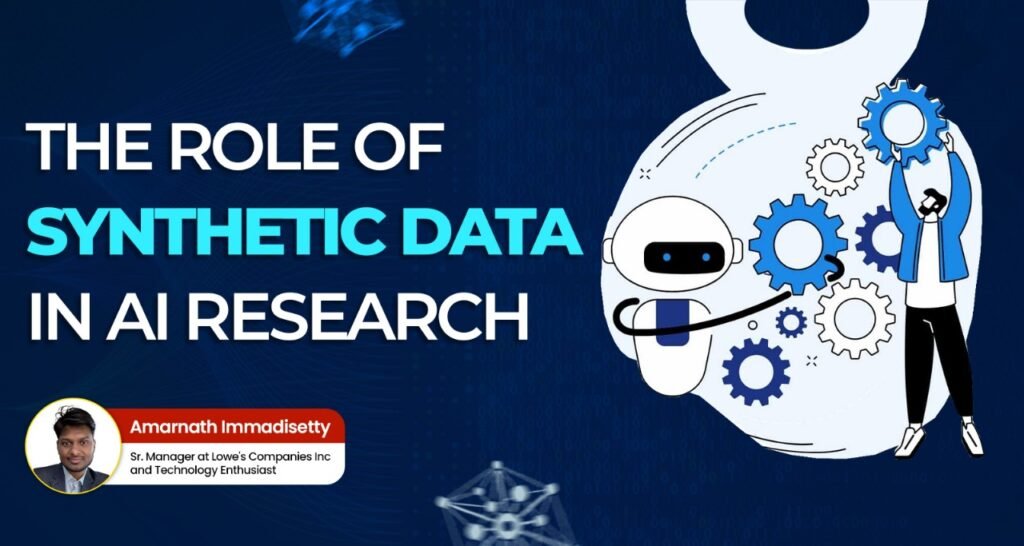
Introduction
Synthetic data has emerged as a transformative tool in the field of artificial intelligence (AI) and machine learning (ML). As organizations increasingly rely on data-driven decision-making, the need for high-quality, diverse datasets has become paramount. However, collecting real-world data can be time-consuming, expensive, and fraught with privacy concerns. Synthetic data addresses these challenges by providing artificially generated datasets that mimic real-world data while ensuring compliance with privacy regulations. This article explores the significance of synthetic data in AI research, its generation methods, advantages, use cases, and future trends.
Understanding Synthetic Data
What is Synthetic Data?
Synthetic data refers to information that is artificially manufactured rather than generated by real-world events. It is created algorithmically and serves as a stand-in for production or operational data, allowing researchers and developers to validate mathematical models and train machine learning algorithms. The ability to generate large volumes of synthetic data quickly and easily makes it an attractive option for organizations looking to enhance their AI capabilities.
Importance of Synthetic Data
The importance of synthetic data lies in its ability to provide several benefits over real-world data:
- Cost-Effectiveness: Gathering high-quality real-world data can be costly. Synthetic data can be generated at a fraction of the cost, making it an economical alternative.
- Privacy Compliance: Synthetic data can help organizations comply with privacy regulations by ensuring that sensitive information is not exposed during testing or training processes.
- Bias Reduction: By generating diverse datasets, synthetic data can help mitigate bias in AI models, ensuring that they perform well across different demographic groups.
- Rapid Prototyping: Researchers can quickly create synthetic datasets tailored to specific needs, enabling faster experimentation and iteration in model development.
How is Synthetic Data Generated?
The process of generating synthetic data varies based on the tools and algorithms used. Here are three common techniques:
1. Random Sampling from Distributions
One straightforward method for creating synthetic data involves randomly selecting numbers from statistical distributions. While this approach does not capture the complexities of real-world data, it can produce datasets that resemble the statistical properties of actual datasets.
2. Agent-Based Modeling
Agent-based modeling simulates interactions between distinct agents—such as individuals or entities—within a defined environment. This technique is particularly useful for studying complex systems where agents interact dynamically. Python packages like Mesa facilitate the development of agent-based models, allowing researchers to visualize interactions through browser-based interfaces.
3. Generative Models
Generative models leverage existing datasets to learn statistical patterns and relationships within the data. These models can then generate new synthetic data that shares similar characteristics with the original dataset. Examples include Generative Adversarial Networks (GANs) and Variational Autoencoders (VAEs), which have been instrumental in producing high-quality synthetic images, text, and other forms of data.
Advantages of Synthetic Data
Synthetic data offers several key advantages:
1. Customizability
Organizations can tailor synthetic datasets to their specific needs, ensuring that they meet particular conditions that may be difficult to obtain with real-world data.
2. Faster Production
Synthetic datasets can be generated quickly using appropriate software tools, significantly reducing the time required to prepare training or testing datasets.
3. Complete Annotation
Synthetic data allows for perfect annotation without manual intervention. Each object in a scene can automatically generate various annotations, making it easier to train supervised learning models.
4. Enhanced Privacy
Synthetic data is designed to resemble real-world data without containing identifiable information about actual individuals or entities, making it suitable for use in sensitive applications such as healthcare.
5. Full User Control
Synthetic data generation provides users with complete control over various aspects of the dataset, including event frequency and item distribution.
Use Cases for Synthetic Data
Synthetic data should accurately reflect the original data it aims to improve upon. Typical use cases include:
1. Testing Software Applications
In software development and quality assurance (QA), synthetic test data offers flexibility and scalability compared to traditional rules-based test data.
2. Training AI/ML Models
Synthetic data is increasingly used to train AI models due to its ability to outperform real-world datasets in certain scenarios while eliminating bias and enhancing explainability.
3. Compliance with Privacy Regulations
Synthetic datasets allow organizations to comply with regulations like GDPR or HIPAA when using sensitive information for testing or training purposes.
4. Healthcare Research
In healthcare, synthetic data enables researchers to extract insights without compromising patient confidentiality by avoiding the use of actual patient records.
Real-World Examples of Synthetic Data Applications
Example 1: Amazon’s Alexa
Amazon uses synthetic data generated through computer graphics and image processing algorithms to train its voice recognition systems for Alexa. This approach allows Amazon to create diverse training scenarios without relying solely on real-world interactions.
Example 2: Waymo’s Self-Driving Cars
Waymo utilizes synthetic data extensively in training its self-driving car algorithms. By generating simulated driving scenarios that include various weather conditions and traffic situations, Waymo enhances its vehicle’s ability to navigate complex environments safely.
Example 3: Financial Services Fraud Detection
In the financial sector, companies like JPMorgan use synthetic transaction datasets that mimic typical debit and credit card payments for fraud detection systems. By testing these systems against synthetic scenarios, they can improve their fraud detection capabilities without exposing actual customer transactions.
Challenges Associated with Synthetic Data
While synthetic data presents numerous advantages, it also comes with challenges:
- Inconsistencies: There may be inconsistencies when trying to replicate the complexity found within original datasets.
- Not a Complete Replacement: Synthetic data cannot entirely replace authentic datasets; accurate real-world examples are still necessary for certain applications.
- Quality Assurance: Ensuring the quality and reliability of synthetic datasets requires careful validation against real-world benchmarks.
The Future of Synthetic Data in AI Research
As AI technologies continue to evolve, the role of synthetic data will expand further:
- Integration with Advanced AI Techniques: Future developments may see deeper integration between synthetic data generation techniques and advanced AI methods such as reinforcement learning.
- Enhanced Realism: Ongoing improvements in generative models will lead to even more realistic synthetic datasets that closely mimic complex real-world scenarios.
- Broader Adoption Across Industries: As awareness of the benefits grows, more industries will adopt synthetic data solutions for various applications ranging from finance to healthcare.
Conclusion
The role of synthetic data in AI research is becoming increasingly vital as organizations strive to harness the power of machine learning while navigating challenges related to cost, privacy, and bias in traditional datasets. By providing customizable, cost-effective alternatives that maintain compliance with privacy regulations, synthetic data empowers researchers and developers alike.
As we look toward a future driven by artificial intelligence and machine learning advancements, embracing synthetic data will be essential for unlocking new opportunities while addressing existing limitations within conventional approaches. Organizations that effectively leverage synthetic data will not only enhance their operational efficiency but also drive innovation across their domains.
The evolution of synthetic data generation techniques promises exciting developments ahead—enabling more robust AI systems capable of tackling complex problems across various sectors while maintaining ethical standards in handling sensitive information.
Amarnath Immadisetty is a seasoned technology leader with over 17 years of experience in software engineering. Currently serving as the Senior Manager of Software Engineering at Lowe’s, he oversees a team of more than 20 engineers. Amarnath is known for driving transformation through innovative solutions in customer data platforms, software development, and large-scale data analytics, significantly enhancing business performance.
Throughout his career, Amarnath has held key positions at notable companies such as Target, Uniqlo, and CMC Limited. His strong foundation in technical leadership and engineering excellence enables him to foster innovation in data-driven decision-making. Passionate about mentoring the next generation of engineers, Amarnath actively promotes diversity and inclusion within the tech industry, believing that diverse teams lead to better innovation and problem-solving.
